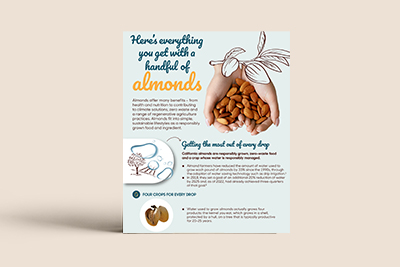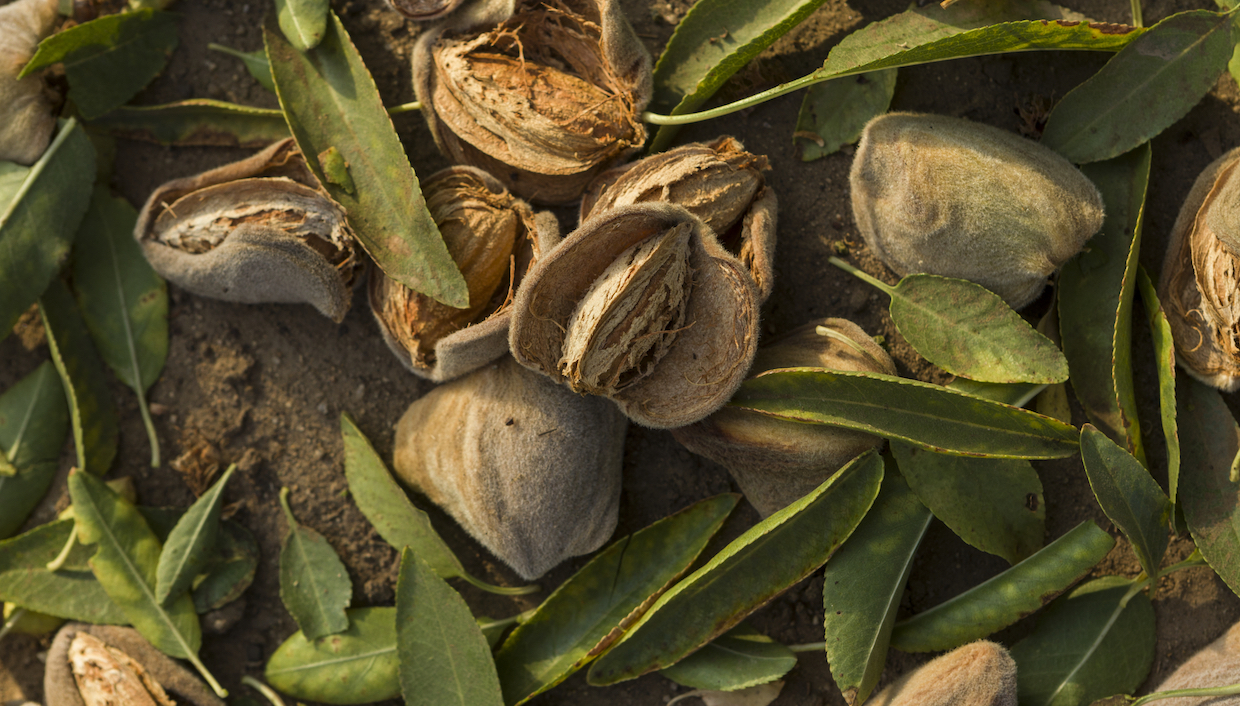Global conditions are driving consumers to examine the value of their food and beverage purchases, and products that deliver on shoppers’ core expectations for taste, personal health and sustainability and best positioned to maintain relevants and demand. For snack manufacturers, the Almond Board of California (ABC) is providing new resources to help inspire innovation and communicate almonds’ standout sustainability story to global consumers.
New Infographic: Everything You Get with a Handful of Almonds
Almonds are a low carbon, low waste and water-efficient ingredient that lend desirable sensory and nutrition benefits to food and beverage products. The latest numbers are in, and ABC has quantified just how big the benefits of almonds are.
- Almond hulls— their fuzzy outer covering— are used in animal feed and offset some of the need to grow alfalfa. This zero-waste approach to using almond hulls saves 440 billion gallons of water annually1. That’s equal to 4 million U.S. households’ annual water use2. or the water volume of Clear Lake in California3!
- Almonds store one of the highest amounts of carbon per acre compared to other fruit and nuts trees in California. In 2022, almond trees in California stored 30 million metric tons of stored carbon. That’s equal to the emissions of 24 million cars4, 3,134 Boeing 737s5, or 29 coal-fired power plants!4
- Nearly half of all California almond farmers have adopted whole orchard recycling, a regenerative practice that grinds up whole almond trees and incorporates them back into the soil at the end of their productive lives, sequestering 2.4 tons of carbon per acre. That’s equal to living car-free for a year!

Everything You Get with a Handful of Almonds
Research: Upcycling Almond Hulls into a Food Ingredient
FoodNavigator-USA recently reported that food scientists at Mattson proved that almond hulls—the soft, fruit-like covering that grows around the shells— can be used as an upcycled ingredient in food and beverage products, with promising applications in high-fiber bars, coffee, tea and potentially even beer.
The project was conceived in collaboration with California’s almond industry to find even higher-value uses for almond coproducts on top of existing uses, like dairy feed. In 2022, almond hulls displaced the need for over 400,000 acres of alfalfa for dairy feed, saving more than 1.3 million acre-feet of water.
Raising Sustainability Awareness Globally: Social Media and Editorial Partnerships
ABC continues collaborating with global influencers and consumer publications to educate on almond sustainability in key markets.
A recent Los Angeles Times editorial partnership shared a long-form video and article about how California almond farmers are responding to climate change in the state. Featuring interviews with farmer Mallvinder Kahal and his family, as well Secretary of the California Department of Food and Agriculture Karen Ross, the content provides context around the role of agriculture, including the almond industry, in combatting climate impacts.
In Germany, the popular women’s lifestyle magazines Brigitte and Brigitte Be Green educated consumers on how California almonds are not just healthy, but grown responsibly too— addressing German consumers’ questions about almonds and water use in a video interview and longform article with farmer Christine Gemperle speaking on the industry’s climate-smart practices, from water efficiency to zero waste and more.
In the U.S., sustainability creators like Ashley Diedenhofen (@sciencebyashley) and Lauren Bash (@relauren) distilled how the California almond industry takes a zero-waste approach to agricultural byproducts by using practices like whole orchard recycling.
U.S. Sustainability Alliance Podcast Feature
In case you missed it, ABC’s Chief Scientific Officer Josette Lewis and USDA research leader Bill Orts discussed the almond industry’s research into new, productive uses for almond coproducts— the hulls, shells and trees. It’s one standout example of how the U.S. supply chain can reduce, upcycle, reuse and eliminate food and postharvest waste. Tune in to the podcast for more.
- UC Davis Department of Agricultural and Resource Economics, 2020 Sample Cost Study Alfalfa Hay and Organic Alfalfa Hay
- Environmental Protection Agency. How We Use Water, 2023. The average US household uses 109,500 gallons annually.
- Lake Lubbers, 2023. Clear Lake’s water volume is 1.16 million acre-feet or 376 billion gallons.
- U.S. Environmental Protection Agency. Greenhouse Gas Equivalencies Calculator. July 2023.
- Reuters. Boeing jets emissions data highlights industry's green challenge. April 2021. Assumes industry average 25-year operable lifespan.
- Emad Jahanzad, et al. Orchard recycling improves climate change adaptation and mitigation potential of almond production systems. PLoS ONE. March 2020
- Seth Wynes, et al. The climate mitigation gap: education and government recommendations miss the most effective individual actions. Environmental Research Letters.

